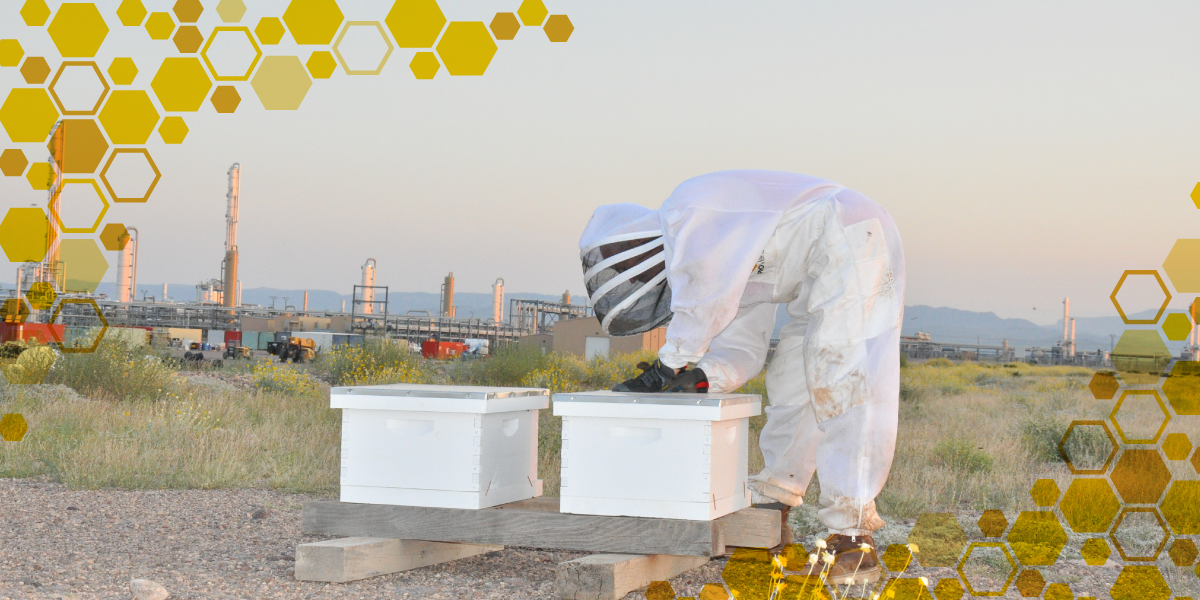
When thousands of feral honeybees swarmed workers at an Altus Midstream compressor station, foreman and professional apiarist (beekeeper) Todd, was called in to help and safely relocate the bees to dedicated hives. Apache Corporation owns 79% of Altus Midstream.
Todd oversees daily operations of the Altus Diamond Cryogenic Gas Processing Facility and Remote Operations Center as well as field compressor stations and treatment facilities.
“The bees had set up home inside several coupling guards, isolated and sheltered from the elements, with a tiny entryway to protect against pests,” explains Todd.
DISCOVERING THE COLONIES
“The guys called me immediately, so I drove out one evening to investigate and found what I thought were three colonies,” he says.

Todd wears protective beekeeper gear as he inspects the bees in residence at the compressor station.
Once he assessed the situation, he spoke with the leadership team about relocating the bees. After addressing their safety concerns, he returned with three bee boxes and bee-keeping equipment to begin the delicate process of extracting the insects from the machinery and transferring them to new quarters.
“It’s best to wait until dusk, when worker bees return home to their queens from their day’s foraging to capture as many as possible, because bees typically travel several miles from the colony,” he continues.
When Todd carefully opened the first housing to reveal a hive, it was large, about 40,000 honeybees. “I could tell by looking at the comb and the amount of honey that the hive was less than a year old,” he enthuses. “And although I couldn’t see the queen, the presence of a brood (bee babies) are a sign that she is there and doing well.”
TRANSFERRING THE RESIDENTS
Using a specialized device designed for safely removing bees, Todd transferred tens of thousands off the honeycomb into a 5-gallon bucket, before removing the comb one piece at a time. He rebound the combs together and placed them into a wooden frame to fit into the beehive along with the bees. At each of the three locations, he transferred them into their respective new boxes.

The device pulls the bees from their honeycomb without disturbing the structure or harming the insects.
SUSTAINING HIVE LIFE
The beehives face south, in full sun, surrounded by native grasses and wildflowers. Thanks to recent rain, there is a lot of pollen. After just six days in their new home, Todd saw more honey in the hives. He says the warm conditions keep predators away, especially hive beetles, who can’t tolerate the heat as well as the bees. “It’s important to protect the bees as you build the hive so that eventually, a strong, thriving colony can naturally keep predators at bay,” he says.

Todd separates the original honeycomb to restructure the hive and move it into the new frames.
And it’s not just pests that threaten wild honeybees. The biggest threat is destruction of their habitat, floral resources and potential areas for them to nest, as well as herbicides and insecticides.
Feral honeybees are fundamental to food security. A third of the world’s food comes from crops that insects pollinate, including Todd’s vegetable garden and fruit trees at his home in northeast Texas.
“If we lose honeybees, there’s a big concern as to how it will affect our food chain because they pollinate so much of the food that we eat,” says Todd.
Globally, bee colonies have dropped drastically in the last decade. In the U.S. in recent years, the government has given agricultural tax exemptions to encourage people to keep bees. Todd and his wife have kept bees for about seven years, after they moved to the country when their children went to college. It began as a hobby to help pollinate their garden and orchard, then grew to a business selling honey from 20 hives.
SHARING THE SWEETNESS
Todd is an expert at harvesting nectar and plans to share the sweet rewards with the Diamond cryo team next July. This will allow the bees to build their honey stock to sustain the colony over the winter and replenish in spring. If they do well and produce a lot of honey, Todd plans to split the larger hive in half.
“From now until then, I’ll look at them at least once a month and check their progress to see how much honey they’re making and storing,” said Todd. “You really shouldn’t open the hives on cold days as the babies – the brood, need a consistent warm environment to thrive, even though the bees themselves can handle colder weather.”

Todd inspects the relocated bees to check their honey production as they fill out the comb to the edges of the new hive.
While some beekeepers will take all the honey and artificially feed their bees through the winter with sugar water or corn syrup, Todd prefers to keep it natural if possible. He’s also interested to know if this honey tastes different to his own. “I live in northeast Texas, 625 miles from the Diamond Cryo hives, and our honey tastes completely different between spring and fall harvest. The honey in the fall is darker and less sweet, and there’s a spicy flavor to it.“
From what he’s seen so far, he’s encouraged by the bees’ progress, building around the comb and filling it out to the limits of the box. “It’s very rewarding to see,” he says.” They are clearly adapting well to their new digs at Diamond.”

Todd stands by the hives, which are positioned for maximum warmth to ward off predators and give the bees the best chance for survival.
ENSURING THEY PROSPER
Todd’s advice for good ‘bee’havior: “Most wild colonies are mild mannered, but some can be aggressive if they feel threatened in their hive. If you see a swarm of wild bees, steer clear and call a local beekeeper or association to remove the colony. Bees are a critical part of our future – so let’s help them prosper.”
Oct. 2021